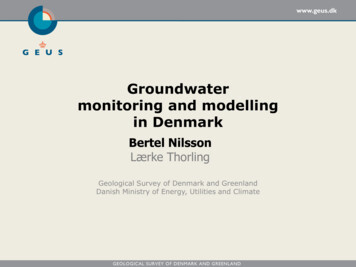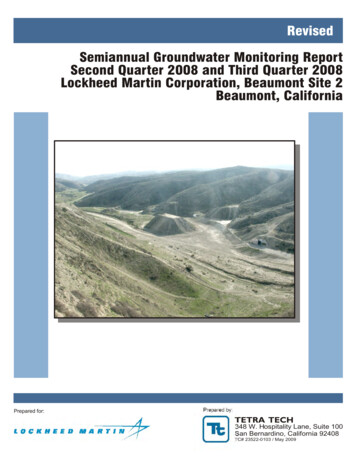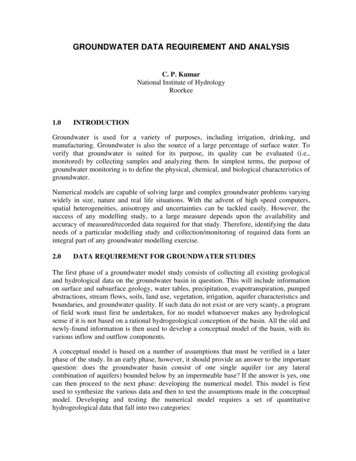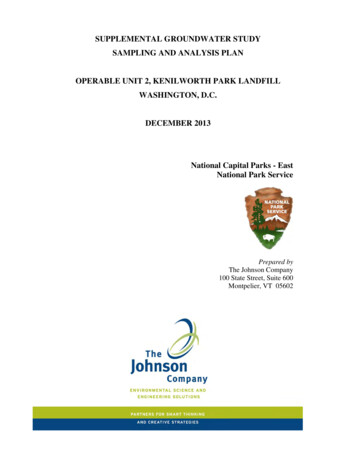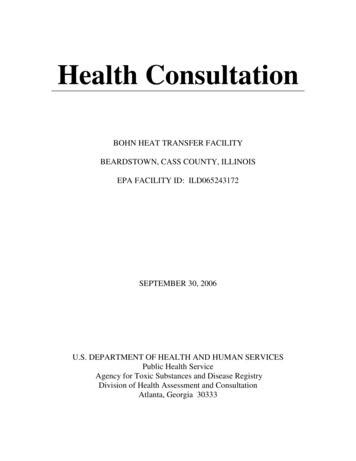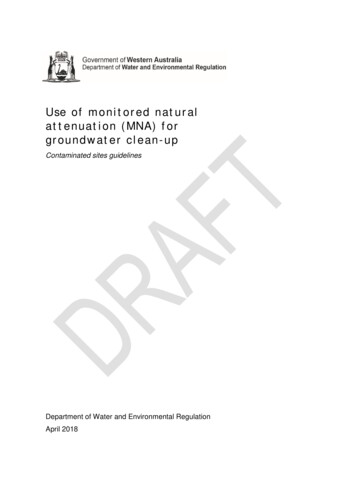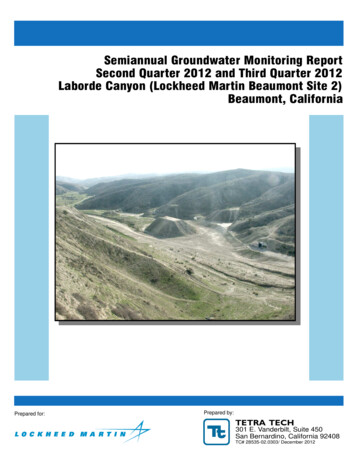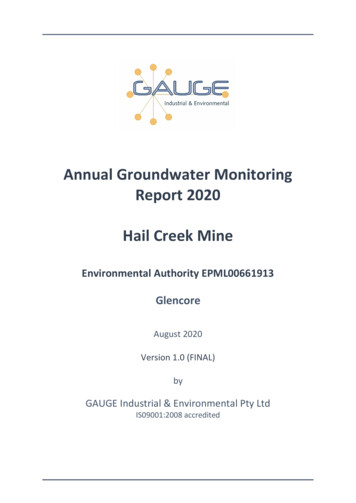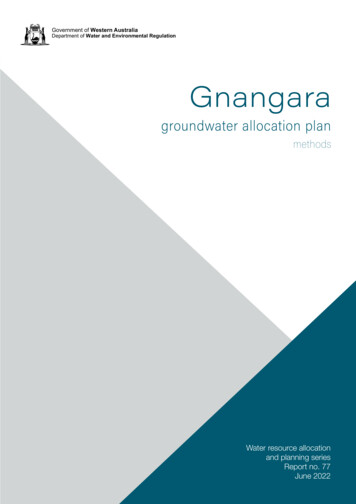
Transcription
Government of Western AustraliaDepartment of Water and Environmental RegulationGnangaragroundwater allocation planmethodsWater resource allocationand planning seriesReport no. 77June 2022
Department of Water and Environmental RegulationPrime House, 8 Davidson TerraceJoondalup, Western Australia 6027Locked Bag 10 Joondalup DC WA 6919Phone: 08 6364 7000Fax: 08 6364 7001National Relay Service 13 36 77dwer.wa.gov.au Government of Western AustraliaJune 2022FIRST 115975This work is copyright. You may download, display, print and reproduce this material in unaltered formonly (retaining this notice) for your personal, non-commercial use or use within your organisation.Apart from any use as permitted under the Copyright Act 1968, all other rights are reserved. Requestsand inquiries concerning reproduction and rights should be addressed to the Department of Water andEnvironmental Regulation.AcknowledgementsThe Department of Water and Environmental Regulation would like to acknowledge the following fortheir contribution to this report: Darryl Abbott, Brad Degens, Natasha Del Borrello, Ben Drew, TrudyEvans, Joel Hall, Michael Hammond, Emily Harrington, Rob Karelse, Gary McCall, Sandie McHugh,Rebecca Palandri, Andrew Paton, Aine Patterson, Shaan Pawley, Jon-Phillippe Pigois, RenéeRowling, Sheryl Ryan, Josephine Searle, Hisayo Thornton, Moe Tiong, Josh Tjioe, Lin Ye, CahitYesertener and Xianwen Yu.For more information about this report, contact: gnangara.planning@dwer.wa.gov.auDisclaimerThis document has been published by the Department of Water and Environmental Regulation. Anyrepresentation, statement, opinion or advice expressed or implied in this publication is made in goodfaith and on the basis that the Department of Water and Environmental Regulation and its employeesare not liable for any damage or loss whatsoever which may occur as a result of action taken or nottaken, as the case may be in respect of any representation, statement, opinion or advice referred toherein. Professional advice should be obtained before applying the information contained in thisdocument to particular circumstances.This publication is available on our website www.dwer.wa.gov.au.You can also request alternativeformats such as audio, large print, or Braille
The Department of Water and Environmental Regulation acknowledgesthe Whadjuk and Yued Noongar peoples as the traditional owners andcustodians of the lands and waters covered by this plan. We pay ourrespects to their elders past and present.Waterwise Perth&PeelThe Gnangara groundwater allocation plan ispart of the State 2019–2021 Waterwise PerthAction Plan which sets the direction for ourtransition to a waterwise city. Our ambition isfor Perth to be a cool, liveable and sustainableplace where people want to live, work andspend their time.The Gnangara groundwater allocation planhelps deliver Action 14 of the Waterwise PerthAction Plan: Review groundwater allocationplans for Gnangara, Perth South and Jandakot,Cockburn and Serpentine to managegroundwater levels for wetlands, urban treesand irrigation of green spaces.
Gnangara groundwater allocation plan: MethodsContentsContents . ivSummary . viii1Introduction .11.11.21.31.41.5Plan area and location .1The Gnangara groundwater allocation plan .1Our process for allocation planning .3Working with water users and other stakeholders .3Waterwise Perth Action Plan .5Part A — Assessing information .62Climate .72.12.23Land use change.93.13.24Seawater interface .22Acid sulfate soils .24Ecological, community and cultural values . 266.16.27Superficial and Mirrabooka aquifers .15Leederville and Yarragadee aquifers .17Water quality . 225.15.26Impacts of land use change on groundwater recharge .9Impacts of land use change on groundwater use .12Groundwater use and resource trends . 134.14.25Past climate trends .7Future climate projections .8Groundwater-dependent ecosystems .26Community and cultural values .31New hydrogeological research and modelling . 367.17.27.37.4Perth Region Confined Aquifer Capacity study .36Perth shallow groundwater systems investigations.36Causes of historic water level decline at Loch McNess (Wagardu) and LakeNowergup.37Groundwater modelling.40Part B — Setting objectives and deciding on the scale of reduced abstraction . 428Setting outcomes and resource objectives . 438.18.29Modelling and assessment of reduced abstraction options . 489.19.29.39.4ivOutcomes.43Water resource objectives .43Input data consistency .48Reduced abstraction options .50Assessment against water resource objectives .56Assessment against water level criteria in Ministerial Statement no.819 .75Department of Water and Environmental Regulation
Water resource allocation and planning series, report no. 7710Deciding the scale of reductions to abstraction . 83Part C — Defining the management approach . 8611Plan strategies . 8711.111.211.311.411.511.6Reduce groundwater abstraction over the next decade .87Encourage efficient use of water .92Encouraging water entitlement transactions .93Alternative source options .94Water for future strategic needs .96Using our monitoring network to review our management.97Appendices . 109Glossary . 119References . 121AppendicesAppendix A — Abstraction assumptions for the ‘no intervention’ scenario . 110Appendix B — Abstraction volumes by component and aquifer for scenarios ofoptions assessed . 114Appendix C — Map information . 115Appendix D — Significant groundwater-related sites listed under the AboriginalHeritage Act 1972 (after Estill 2005) . 116FiguresFigure 1Figure 2Figure 3Figure 4Figure 5Figure 6Figure 7Figure 8Figure 9Figure 10Figure 11The Gnangara groundwater allocation plan area .2Our water allocation planning model for Western Australia .3Annual rainfall at the Perth Airport rainfall station 9021 from 1975–2020.7Historical and projected rainfall at the Perth Airport rainfall station 9021 8Likely post-harvest land use in the Gnangara, Pinjar and Yanchep pineplantations . 11Groundwater use from the Gnangara system 2019–20 . 13Cross-section showing the structure of the Gnangara system, layeringof major aquifers and confining units, connection between aquifers,directions of groundwater movement, the saltwater interface andDarling Fault . 14Trends in Superficial aquifer levels . 16More than 1,000 gigalitres of groundwater storage has been lost fromthe Superficial Aquifer since 1980 . 17Groundwater connectivity of the Leederville aquifer, with abstractionlocations and volumes . 19Groundwater connectivity of the Yarragadee aquifer, with abstractionlocations and volumes . 20Department of Water and Environmental Regulationv
Gnangara groundwater allocation plan: MethodsFigure 12Figure 13Figure 14Figure 15Figure 16Figure 17Figure 18Figure 19Figure 20Figure 21Figure 22Figure 23Figure 24Figure 25Figure 26Figure 27Figure 28Figure 29Figure 30Figure 31Figure 32Figure 33Figure 34Figure 35viTrends in pressure heads in the Leederville aquifer and Yarragadeeaquifer . 21Conceptual representation of fresh groundwater interacting and mixingwith saline water in a coastal aquifer . 22Saline water intrusion and acidity risk zones . 23Conceptual representation of acid sulfate soils and water level declinesleading to acidity in groundwater . 24Significant groundwater-dependent ecosystems supported by theGnangara groundwater system . 30Significant groundwater-related Registered Aboriginal Sites asdescribed by Estill & Associates 2005 . 35Groundwater level declines have led to drying and terrestrialisation ofLoch McNess (Wagardu) in Yanchep National Park (Photographers:DWER and ECU.) . 38PRAMS 3.5 modelled rainfall verses observed rainfall (2013 to 2019) . 41Model input data for current land use (a) and future land use at 2030 (b). 49Scale of reduced abstraction under different allocation options . 51Lower- and higher-risk subareas based on assessment of local impactsto the resource and environment . 55Water level change in the Superficial aquifer under the ‘no intervention’scenario . 60Water level change in the Superficial aquifer under Option 1 (a) anddifference in levels compared with ‘no intervention’ (b) . 61Water level change in the Superficial aquifer under Option 2 (a),difference in levels compared with ‘no intervention’ (b) and difference inlevels compared with Option 1 (c) . 62Water level change in the Superficial aquifer under Option 3 (a),difference in levels compared with ‘no intervention’ (b) and difference inlevels compared with Option 2 (c) . 63Water level change in the Superficial aquifer under Option 4 (a),difference in levels compared with ‘no intervention’ (b) and difference inlevels compared with Option 3 (c) . 64Pressure head change in the Leederville aquifer under the ‘nointervention’ scenario. 65Pressure head change in the Leederville aquifer under Option 1 (a) andOption 2 (b) . 66Pressure head change in the Leederville aquifer under Option 3 (a) andOption 4 (b) . 67Pressure head change in the Yarragadee aquifer under the ‘nointervention’ scenario. 68Pressure head change in the Yarragadee aquifer under Option 1 (a)and Option 2 (b) . 69Pressure head change in the Yarragadee aquifer under Option 3 (a)and Option 4 (b) . 70Change in area that meets the ‘ecological water requirement surface’compared with the baseline year . 82Components of the allocation limits for the Gnangara plan area . 96Department of Water and Environmental Regulation
Water resource allocation and planning series, report no. 77Figure 36Location of sites in the Gnangara plan area with existing and proposedwater level thresholds . 100TablesTable 1Table 2Table 3Table 4Table 5Table 6Table 7Table 8Table 9Table 10Table 11Table 12Table 13Table 14Calibration statistics for PRAMS 3.5 for the original calibration periodcompared with the statistics with measured data to 2019 . 41Water resource objectives for the Gnangara allocation plan . 46Summary of reduced abstraction options . 52Summary of the model results for each reduced abstraction optionassessed against the plan’s objectives. 58Summary of model results for the ‘no intervention’ scenario and‘reduced abstraction’ options assessed against water resource objective3. . 72Summary of assessment of the ‘no intervention’ scenario and ‘reducedabstraction’ options against water resource objective 4. . 74Risk of non-compliance with water level criteria . 78Non-compliant sites where water levels were projected to increase . 79Risk of currently compliant sites becoming non-compliant . 80Reduction decision compared with the other tested options . 85Proposed ecological threshold levels at groundwater-dependentecosystems in the plan area* . 101Public water supply reserves along the North West corridor (GL) . 111Likely reductions in abstraction in East Wanneroo because of land usechange (GL) . 112Estimated future water needs for basic raw material extraction (GL) . 112Department of Water and Environmental Regulationvii
Gnangara groundwater allocation plan: MethodsSummaryClimate change means Perth must become even more waterwise. Our city needs toadjust to using less groundwater to achieve the same productivity and amenitybenefits we are used to. The amount of water being taken from the Gnangaragroundwater system exceeds the amount of water recharging the system. Reducingabstraction will protect important wetlands and native bushland by making them moreresilient to climate change, prevent further declines in water quality and help ensurethe long-term sustainability of the groundwater resource.The Department of Water and Environmental Regulation has created the Gnangaragroundwater allocation plan (DWER 2022a).to address this water imbalance andsecure the Gnangara groundwater system as a long-term sustainable water resourcethat supports a healthy environment for Perth.What is this report?This report is a companion to the Gnangara groundwater allocation plan. The plandetails how the Department of Water and Environmental Regulation will manage,license and monitor groundwater in the Gnangara groundwater system. This reportexplains how we developed the plan and details the hydrogeological, environmental,cultural and community information that underpinned our decision-making.What does this report include?In line with our approach to allocation planning in the guideline Water allocationplanning in Western Australia (DoW 2011e), this report has three main parts: Part A: describes the information we assessed to develop the plan Part B: outlines how we set the plan’s objectives and the methodology fordeciding on the scale of reductions to abstraction Part C: describes our management approach to meet the plan’s outcomes andobjectives.For more information about the plan, send an email tognangara.planning@dwer.wa.gov.au and see the References section for a list oftechnical documents.viiiDepartment of Water and Environmental Regulation
Water resource allocation and planning series, report no. 771Introduction1.1Plan area and locationThe Gnangara plan covers about 2,200 km2 of the Swan coastal plain, extendingnorth from the Swan River (Derbarl Yerrigan) in Perth, Western Australia. The planarea is bound by the Swan River (Derbarl Yerrigan) to the south, the Moore Riverand Gingin Brook to the north, the Darling Scarp to the east, and the Indian Ocean tothe west (Figure 1).1.2The Gnangara groundwater allocation planThe Department of Water and Environmental Regulation issues licences under theRights in Water and Irrigation Act 1914 (WA) to regulate and manage groundwaterabstraction in the plan area.The Gnangara groundwater allocation plan (DWER 2022a) replaces the Gnangaragroundwater areas allocation plan (DoW 2009a). Key features of the plan are: new groundwater level and water quality objectives a more sustainable allocation regime for groundwater across the system a pathway to reduce the amount of groundwater being used over the nextdecade.The plan sets out how we will use water licensing and other mechanisms to‘rebalance’ the Gnangara system to: reduce groundwater abstraction to better match declining water availabilityunder climate change stabilise or recover groundwater levels in some areas with long-term declinesto protect important wetlands and bushland from the effects of groundwaterabstraction help safeguard the long-term, sustainable use of the groundwater system as aresource for Perth’s community.This report describes how we determined the necessary reductions to the volume ofabstraction, and how these reductions will be shared by water users.Department of Water and Environmental Regulation1
Gnangara groundwater allocation plan: MethodsFigure 12The Gnangara groundwater allocation plan areaDepartment of Water and Environmental Regulation
Water resource allocation and planning series, report no. 771.3Our process for allocation planningWe developed the Gnangara planusing our standard allocationplanning model (Figure 2). Thisreport describes:Figure 21.4Our water allocation planningmodel for Western Australia Part A – Our assessmentsof climate, groundwateruse, water resource trends,impacts to values thatgroundwater supports, newhydrogeological research,and modelling. Part B – The objectives andmethod we used to decideon the scale of reductionsto abstraction using futureclimate projections. Part C – Our approach tosharing the reductionsacross all water users andmanaging the groundwaterresource as climate changecontinues.For more information aboutallocation planning, see Waterallocation planning in WesternAustralia: a guide to our process(DoW 2011e).Working with water users and otherstakeholdersTo develop the Gnangara plan, we held more than 100 workshops and meetings withgroups and individuals across different water use sectors, including the WaterCorporation, local governments, agricultural organisations and environmental groups.The consultation followed three main phases:1. Science update – beginning in 2016 we shared the latest science andresearch with stakeholders, including groundwater modelling of thepast effects and future projections of groundwater abstraction, climate andland use change.2. Licensing strategy – we then asked representatives from the major water usesectors for their input, including how they thought their industry would respondto reduced groundwater availability.Department of Water and Environmental Regulation3
Gnangara groundwater allocation plan: Methods3. Option assessment – from late 2017 onwards our discussions withrepresentatives from the major water use sectors, other agencies and groupsinterested in Gnangara groundwater planning began to focus on potentialwater allocation options and underlying licensing approaches.Our stakeholders raised a variety of issues during the consultation phases. Theyasked about or pointed to: the necessity, costs and benefits of reducing abstraction the implications for public open space, agriculture and businesses low water levels at lakes and wetlands, and protecting banksia woodlands licensees having enough time to adapt to reduce their groundwater use which sector/s were responsible for causing the groundwater level declines future land use and water demands, including groundwater availability inurban growth areas, and the potential need for alternative water supplies ways to target inefficient and wasteful water use how reductions should be spread across different water use sectors opportunities to trade water the high number of garden bores and their potential impact on thegroundwater system over time.To keep water licensees and the wider community informed, in May 2018 wereleased the brochure Our groundwater future in Perth: Securing Gnangaragroundwater and adapting to climate change (DWER 2018a) and launched theGnangara groundwater website gnangara.dwer.wa.gov.au .The brochure was posted to 2,600 individual licensees in 2018 with a letter to advisethem that Gnangara planning work was underway. The letter also described the likelychanges to their groundwater licences and let them know they could formallycomment on the plan during a three-month public comment period.Since 2019 we have worked with key stakeholders and agencies to considerapproaches for each sector to transition and adapt to reduced water use because ofclimate change. These discussions have informed several State Governmentinitiatives to help groundwater users adjust to using less water – see Chapter 11 formore information.The department finalised and made changes to the plan in response to submissionswe received on the plan and stakeholder engagement held during a three-monthpublic comment period. This is summarised in Sections 1.5.2 and 1.6 of the plan(DWER 2022a) and detailed in the Gnangara groundwater allocation plan: Statementof response (DWER 2022b).4Department of Water and Environmental Regulation
Water resource allocation and planning series, report no. 771.5Waterwise Perth Action PlanIn October 2019, the State Government released the Waterwise Perth Action Plan aspart of its response to climate change. The plan sets the groundwork for a 10-yearprogram to ensure Perth remains beautiful, green and liveable by becoming a leadingwaterwise city (Government of Western Australia 2019). The action plan has 38actions to achieve nine targets by 2030, one of which is to reduce groundwater useby 10 per cent across the Perth-Peel region. Delivery of a new Gnangaragroundwater allocation plan is action 14 under the Waterwise Perth Action Plan.Department of Water and Environmental Regulation5
Gnangara groundwater allocation plan: MethodsPart A — Assessing informationIn Part A of the plan development process, we assessed: past climate trends and future climate projections land use change impacts on recharge and groundwater use groundwater use, aquifer trends and impacts on water quality the ecological, community and cultural values that groundwater supports new hydrogeological research and groundwater modelling.Key points from Part A:6 Climate change has led to a decline in rainfall and recharge to groundwateracross south-west Western Australia since the 1970s. There is highconfidence in global climate models, coupled with future emissionsprojections, that the Gnangara plan area will have a warmer and drier climatein the future. Urban growth and other land use change will result in changes to groundwaterrecharge and how water is used in parts of the plan area. Levels in the Superficial aquifer have generally declined in the past 40 yearsdue to climate change, abstraction and pine plantations (which limit recharge). Hydraulic pressure in the Leederville and Yarragadee aquifers has declinedsince the 1980s as groundwater abstraction from those aquifers, mostly forpublic water supply, has increased. Pumping from the Leederville and Yarragadee aquifers can directly affect theSuperficial aquifer where they are connected. This impacts on groundwaterdependent ecosystems and other groundwater users. Rising salinity associated with abstraction has been recorded in Yanchep,Quinns, on the Cottesloe-Mosman peninsula and along the Swan River(Derbarl Yerrigan) in the Swan Valley. Declines in water levels have exposed acid sulfate soils in the Superficialaquifer, causing shallow groundwater acidification over more than 15 per cent(380 km2) of the plan area including around some abstraction bores and insensitive areas such as Mussel Pool in Whiteman Park. More sites no longer comply with environmental water level criteria inMinisterial Statement no. 819 compared with the 2009 Gnangara plan. Preventing further degradation of groundwater-dependent ecosystems is asimportant for the community of Perth as it is for our wildlife. New hydrogeological studies, such as the Perth Regional Confined AquiferCapacity (PRCAC) study, the Perth shallow groundwater systemsinvestigations and a major update of the Perth Regional Aquifer ModellingSystem (PRAMS) have improved how we manage abstraction from theGnangara system.Department of Water and Environmental Regulation
Water resource allocation and planning series, report no. 772Climate2.1Past climate trendsGnangara groundwater aquifers are recharged by rainfall, primarily in winter andspring. Climate change has caused a significant reduction in Perth’s average rainfall,which in turn is impacting on these aquifers, and the values they support.Average annual rainfall has declined 15 per cent since 1975 at the Perth Airportstation, from 841 mm/year (1945–1974) to 708 mm/year (1975–2020). Most of thereduction in average annual rainfall is because of less rain falling between April andJuly each year. As a result, recharge to the groundwater system often starts later inthe year and is now much less than it was.Over the same time periods there was nearly a 1 C increase in annual averagemaximum temperature, with the six hottest years on record for Perth Airport stationoccurring in the past eight years. Higher temperatures increase evapotranspirationloss from groundwater, and people use more water when it is hotter.When we developed the 2009 Gnangara groundwater areas allocation plan, averageannual rainfall at Perth Airport station had fallen to 729 mm/year (1975–2008). Since1990, the average has been 699 mm/year, with three of the driest years rec
to our monitoring network of representative ecosystems. The initial rounds of the groundwater modelling we used to develop the water resource objectives listed in Table 2, attempted to find a groundwater reduction scenario that would improve water levels at the representative sites. This was to
